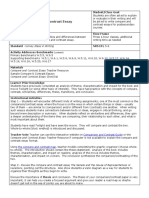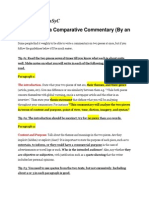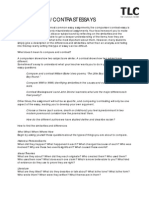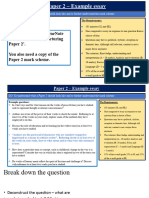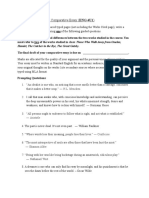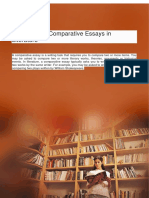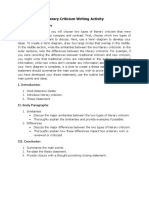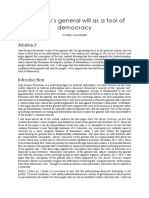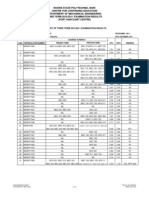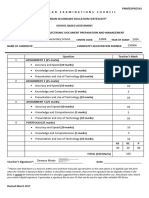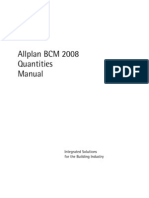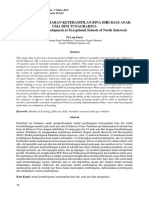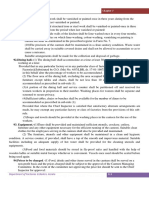A GUIDE TO CL SEARCH AND CL FINAL PAPER
1. Assignment: After reading two novels selected, you will write a Final paper based on
comparison/contrast essay using the guidelines given.
Comparison/Contrast explained - The process of examining two or more things in order to establish
their similarities and differences.
1. Write your final paper based on the books read and analysed by your group.
2. The final paper should consist of the following sections:
a. Section A: A synopsis of the novels
b. Section B: A one-page concept map
c. Section C: A three-part essay
3. Your final paper should not exceed more than 5 pages (max. 2,000 words), and should be typed
double-spaced, using Tahoma 11 pt.
4. Your final paper should reflect your own understanding about the theory of literary criticism, and
should focus on authors’ perspective on the subject.
Bearing in mind that:
i. Any relationship between two or more things will involve some degree of SIMILARITY, as
well as some degree of DIFFERENCE.
ii. Comparisons can be found in any kind of writing/genres: magazine articles, advertising,
essays, news articles, letters, editorials, textbooks, scientific writing, reports, political
speeches, and pamphlets.
iii. We make comparisons when we have to choose between two or more things: careers,
products, political candidates, goals, etc.
iv. Comparisons underlie everything we do: Scientists use comparisons in their experiments.
Logicians use them to draw conclusions. Politicians use them to formulate policies. Judges
use them to render decisions, etc.
2. How to Write a Literary Comparison/Contrast Essay
When writing a literary comparison, you will answer the question:
So What?
In other words, you will not only explain the similarities and differences between the two (or more)
literary works, but also explain the significance of your comparison. A comparison intends to inform
readers of something they haven’t thought of before. Therefore, for a comparison to be illuminating,
the things compared must either:
1. Appear different but have significant similarities; i.e., Star Wars and Return of the Jedi.
� 2. Or, appear similar but have significant differences; i.e., Classic Star Trek and Star Trek:
The Next Generation.
You must have a purpose for your comparison. The reader of the comparison should not have to ask
SO WHAT? at the end of your essay. In a comparison/contrast essay you are explaining the
differences between two or more things, as well as explaining, or at least alluding to, what the two
things have in common. Remember that comparison and contrast is an organizational and analytical
structure that supports your ideas, but you still need a thesis in the introduction.
The introduction should contain:
1) The names the items to be compared
2) The purpose of the comparison
3) What is being compared and/or contrasted
Sample Thesis Statements:
Unacceptable — “I am going to compare the similarities and differences between the films Close
Encounters of the Third Kind and E.T., the Extraterrestrial.”
Acceptable — “A close examination of the way Roy Neary, the protagonist of Close Encounters of
the Third Kind, and Elliott, the protagonist of E.T., the Extraterrestrial, react to their encounters with
aliens demonstrates that director Steven Spielberg uses both films to tell similar stories about the
difficulties of growing up in psychoanalytic sense.”
The Beginning into Compare/Contrast the Literary Theories in the Novels.
1. Choose the works of literature you want to compare.
2. Choose the grounds for comparison; i.e. is there something they have in common that makes it
worthwhile to show how they are different?
3. Answer the question So What? by determining a purpose for making a comparison.
4. Gather information and evidence pertaining to literary theories from each novel to describe and
support your grounds for comparison. Use a graphic organizer.
5. Outline your essay.
6. Compose your thesis.
7. Write the draft of your essay.
3. Final Paper Directions
Step One
�Select two novels that can be compared and contrasted from the authors’ point of view, literary style,
or other points of comparison. Once you have the novels, it’s time to decide “what” within each
selection you will compare.
Step Two
Make a graphic organizer. Making notes on the organizer will help visually show you how items, such
as characters, author’s development of the plot, author’s use of literary devices, theme, etc. are similar
and different. If you decide to focus on just “theme,” for example, then you will want to create a Venn
diagram or comparison chart that helps you analyze how the two authors’ word choices, style, sense
of audience, etc. are used to reveal the theme to the reader or support the message. And, of course,
compare the authors in this regard.
Step Three
Once you have jotted notes in the graphic organizer, make an outline for your essay, that includes:
(Sample structure)
Paragraph 1: The Introduction - Introduce your topic and state your thesis. Example Thesis:
“Although James Jackson’s novel, Reaching the English Moors, was written in 1895, the
theme can be compared to H.B. Bartlion’s poem, ‘Green Grasses of Home’ written a century
later. Both Jackson and Bartlion are urging the reader to consider the life lessons presented in
nature. However, Jackson addresses this theme through the use of personification and
Bartlion relies on visual imagery.” In the above example, the writer has established why the
two selections are comparable (common themes), but clearly states that the authors have used
two contrasting methods of developing their themes. So, will the writer focus on the alikeness
(comparison) of the theme, or the different ways (contrast) the authors developed their theme?
Paragraph 2: First Support Paragraph. Set the groundwork for the similarities in the literary
selections. In the case above, you would describe the common theme found in each selection.
Write a topic sentence and add details to support your topic sentence. Example Topic
Sentence: “Both Jackson and Bartlion are urging the reader to consider the life lessons we can
learn from nature.” Provide specific examples of this in the paragraph.
Paragraph 3: Second Support Paragraph. Again, write a topic sentence and add at least 3
details. This paragraph will focus a difference between to the two literary selections by stating
that Jackson uses personification to develop the theme. Provide specific examples of this in
the paragraph.
Paragraph 4: Third Support Paragraph. This paragraph will focus on another difference
between the two literary selections by stating that Bartlion uses visual imagery to develop the
theme. Provide specific examples of this in the paragraph. Include several supporting details.
Paragraph 5: Conclusion. Go back and state what you’ve already said in the introduction
using different wording, wrapping things up.
Step 1 -3: CL Search paper to be submitted in the 7th week for approval by your lecturer, before
you can proceed to Step 4 and 5.
�Step Four
Use the outline (above). Write each section of the paper, until finished. Go back and edit, checking for
spelling, correct grammar, punctuation, and flow. Use the scoring guide/rubric given in your TE40003
sylsyn to check the completion and correctness of your essay. Compare and contrast essays are just
like any other paper and should flow from one paragraph to the next, making sense as you read it.
Read and reread. Polish things up and submit in WORD document.
Step Five
Prepare a brief presentation of your Final paper in poster/power-point template. Submit it together
with your Final paper in different file.
Step 4 – 5: To be submitted as Final paper in the 12th week , Paper presentation will be in week
13 and 14 ( 15 minutes presentation via VOOV).
�Brief Guide
Formalism
Methodology
1. Begin reading by firstly identifying the various linguistic features of the respective
text, that is, the repetition of the word or the repetition of certain phrase
2. Then prompted to connect the repetition of the above to an idea that they seemed to
emphasise.
3. Then think about whether the repetitions of the identified words and phrases created
certain patterns of sound in the text?
4. Once established the above, identify points in which the above patterns were broken,
i.e if a once repeated phrase appears in a different form or in a different arrangement
and whether this altered its earlier meaning?
5. After all the above had been recorded, study the patterns of parallelisms and
deviations, similarities and contrasts that were created and to determine whether they
centred on a common issue, what is otherwise known as the theme of the story.
Consequently, come to the realization that all the above aspects of the story identified
were devices that helped to reinforce the main theme.
Reader Response
Methodology
1. Begin with studying the title of the text and noting down what associations first came
to mind.
2. Then begin reading the text and noting down details of their responses to particular
words, phrases, passages, that is:
What were certain feelings that they evoked? Did they think further about the
meaning of these details?
Did they create links between what was read and familiar events?
What judgments were made about specific characters, events, passages,
words?
Were all the above influenced by personal memories and associations?
� 3. Think of other sources that can be used to fill in the gaps in their understanding of
unfamiliar content in the text, that is, dictionaries, cultural texts, communities etc
4. Once recorded all the above, they are then to reassess their first assumption (based on
the title) and note down how this has changed and why. This way they become more
aware of the process involved in the act of reading and move towards substantiating
and supplementing their understanding of the content of the text.
Psychoanalysis
Methodology
1. Determine, through detailed evidence from the text, the different kinds of characters
that exist in the text by dividing them into the following categories:
a) Characters who are more concerned with pleasing themselves themselves at
the expense of others, that is, those who show no regard for social
conventions, ethics or lack of moral restraint and have no regard of
consequences as a result of their actions.
b) Characters who are concerned only with social rules an regulations, that is,
family, religious, the law and consequently suppress their own individual
needs and desires.
c) Characters who balance the extremes of (a) and (b) by fulfilling the needs and
obligations that are necessary without overtly suppressing or indulging the
self.
2. Discuss whether the above traits create conflicts within the characters as well as with
other characters in the text, that is, feelings of guilt or suppression of needs, feelings
of envy etc.
3. Once established the above, then led deeper into the aspect of characterization by
being asked to analyse the various literary devices used in the text and to determine if
these aid in the aspect of characterization. For instance, do certain do certain images
or the use of certain colours in relation to the characters reveal more insights into the
character?
4. Once recorded all the above, have a good grasp of the characters in the story and be
able to substantiate their responses through such detailed analysis.
�Feminism
Methodology
First determine the differences, if any, in the portrayal of the male characters are compared to
female characters through focusing on the following:
1. Do male characters dominate the dialogue found in the text?
2. What status do female characters have in the text? For instances are they secondary to
male characters through either being voiceless or nameless?
3. How are women described? For instance are they
I. Described in ways that focus on physical traits instead of their inner thoughts
and power of reasoning?
II. Compared to women characters from mythology or legend?
4. How do female characters interact with the male characters? Are they timid or more
vocal? Are their roles confined to only that of daughter/sister/wife/mother?
5. Do male characters oppress the women through certain actions or words?
6. Are there any female characters who resist traditional expectations of women? For
instance do any female characters
I. Voice their own opinions as opposed to merely submitting to those of the male
characters?
II. Act against oppression by the male characters?
III. Speak up against injustice to other women characters?
IV. Resist the fixed female roles that they are expected to conform to by behaving
in unconventional ways?
7. Having determined most of the above, think about what they reveal about gender
relations and status of men and women in the selected literary text? Are men and
women treated as equal or do men have an unfair advantage over women?
Consequently, does the text also reveal ways in which women can resist gender
oppression?

















